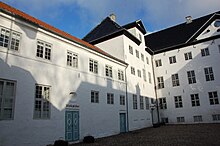Dragsholm Castle
The Dragsholm Castle ( Danish : Dragsholm Slot ), formerly Adelersborg called, is a castle in the Danish community odsherred municipality on the island of Zealand .
location
The castle complex, surrounded by a small forest and a park, is located south of the village of Vindekilde , east of the Nekselø Bugt bay , which belongs to the Kattegat, at Dragsholm Allé , 4534 Hørve . The Dragsholm Canal runs south of the castle .
Originally, the fortress secured the isthmus via which the Odsherreds peninsula can be reached. The name of the castle means: island ( holm ) on the isthmus ( drag / draft ). However, when the Lammefjord was drained in the 19th century, this isthmus no longer exists.
history
The complex was probably built around 1215 as the palatium of the Roskild bishop Peter Sunesen . It is the oldest preserved secular building in Denmark. In 1336 it was first referred to as Draugsholm . This oldest building consisted of a hall with living and utility rooms underneath.
In the following centuries the castle was expanded to become the strongest fortress in the country. During the count's feud , it was the only castle that resisted, although Johann von Hoya besieged it for five months. After the victory of King Christian III. The castle, like other church property, was confiscated by the Danish crown during the Reformation and given as a fief . A prison was set up in the tower. The deposed last Catholic bishop of Roskilde and owner of the castle until 1536, Joachim Rønnow, who had long opposed the new Protestant king, was one of the first prisoners. The most prominent prisoner was James Hepburn, Earl of Bothwell , the third husband of Maria Stuart , who died in the castle in 1578 after five years of imprisonment and was buried in the nearby Fårevejle Kirke . During the following decades the castle fell into disrepair. It was not until Reichsadmiral Claus Daa (1579–1641), who received the fiefdom in 1624, commissioned a master builder, Hansvan Steenwinckel the Younger , with the repairs.
During the war against Sweden , the castle was captured by Swedish troops in 1657 and blown up in 1660. King Friedrich III. sold the ruins in 1664 to the merchant, chamberlain and rent master Henrik Müller , who had made considerable profits from the war. With the purchase of the castle, however, he had taken over, as the purchase price far exceeded the value of the castle and the office that went with it. After two further sales, Dragsholm came in 1694 to the later bailiff of Roskilde Frederik Christian von Adeler. Adeler had the castle rebuilt as the baroque palace that exists today . However, many elements of the medieval castle have been retained. Under the noble family, Dragsholm became a barony in 1784 and was named Adelersborg in 1785 . The Lammefjord was diked under his descendant Georg Frederik Otto Zytphen-Adeler . He also reintroduced the old name Dragsholm in 1868 . After the family died out, the castle fell to the Danish state in 1932. It has been used as a hotel since 1937.
The diplomat and statesman Friedrich Christian Ferdinand von Pechlin (1789–1863) died in the palace.
Today the castle is used as a hotel, restaurant and farm shop. There is also a horse-drawn carriage museum on the site.
Tombs of the Ertebølle culture were found south of the castle .
literature
- Ingrid Falktoft Anderson: Vejviser til Danmarks oldtid . 1994, ISBN 87-89531-10-8 p. 239
Web links
Individual evidence
Coordinates: 55 ° 46 ′ 15.9 ″ N , 11 ° 23 ′ 27.6 ″ E

